George Thomas West, 1867 - 1946
“G.T.W.”
by Brian Stevenson
last updated February, 2025
George T. West’s life took an unexpected twist after the turn of the twentieth century. Son of a Dorset boot maker, George moved to London during the early 1890s and opened his own shoe making business in the Camden Town area. He developed an interest in microscope, and joined the Quekett Microscopical Club in 1899. That same year, he published a description of a “stage table” that he invented, and was later marketed by Watson & Sons. West evidently studied diatoms and plant structures with his microscope, and gained sufficient knowledge to be hired as a Lecturer in Botany at the University College of Dundee, Scotland ca. 1905. He became a well-known botanist, specializing in diatoms. West also published a well-received book on photomicrography.
Note that there was another academic botanist active at the same time who had a similar name: George Stephen West (1876-1919). I found several examples in the literature of confusion between G.T. West and G.S. West. George S. West was Professor of Botany at the University of Birmingham. He was also a son and work colleague of William West (1848-1914), a botanist, slide-maker, and distributor of the microscope slides of Jean Claudius Tempère (1847-1926), both of whom are subjects of separate essays on microscopist.net.
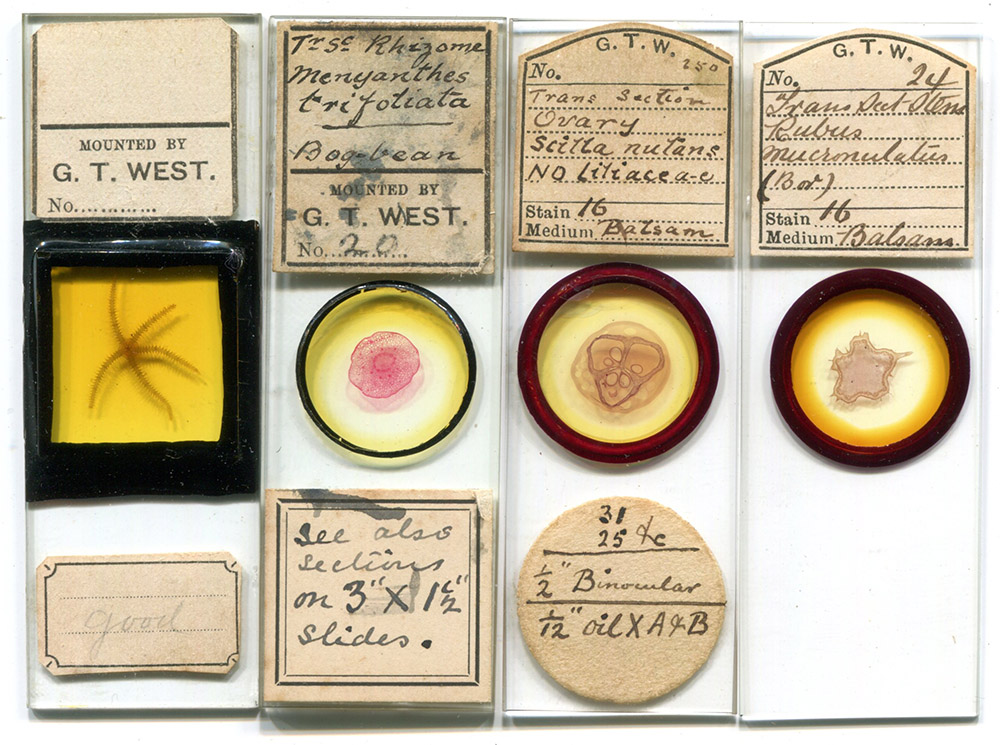
Figure 1.
Microscope slides by George T. West, with labels printed with “G.T. West” or “G.T.W.” A slide with a “G.T.W.” label that is dated 1908 is shown in Figure 2. These and the slide shown in Figure 1 evidently came from West’s personal collection, and many include information on his mounting technique, preferred objective lens, or other insights.
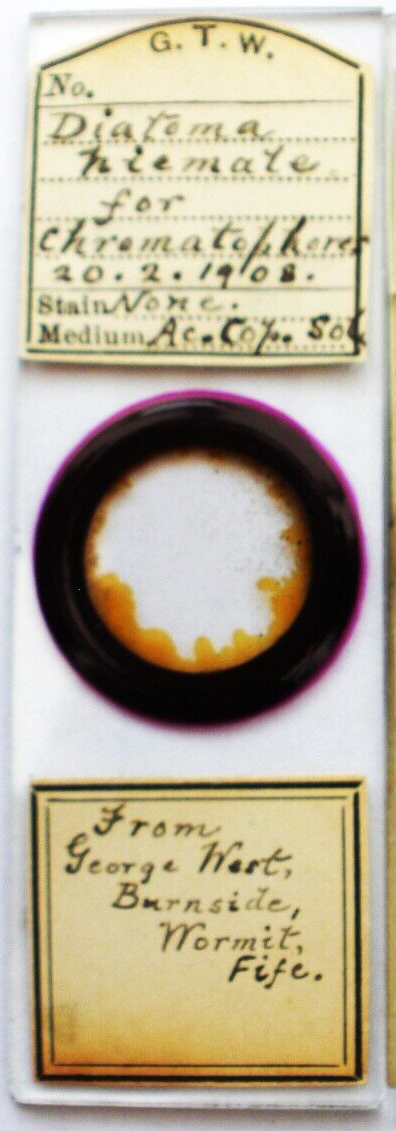
Figure 2.
A microscope slide by G.T. West that is dated February 2, 1908, with his first name spelled out and his Scottish home address of Burnside, Wormit, Fife. Adapted for nonprofit, educational purposes from an internet auction site.
George Thomas West was born on December 18, 1867, in Ventnor, Isle of Wight, son of Richard and Emma West. Father Richard was recorded in the 1881 national census as being a “boot maker”.
George left home during the 1880s, moving to Melcombe Regis, Dorset. The 1891 census found him as a lodger, and working as a “clothier’s assistant”. Within a couple of years, he moved to London. On November 7, 1895, George married Emma Charlotte Hall. The 1901 census recorded that he was a “shoe maker”, an “employer”, and working “at home”, indicating that he had a shop in the house, and hired at least one assistant. That census also reported that the Wests had a domestic servant, and were thus solidly middle-class.
George West had become an expert microscopist by the end of the 1890s. In early 1899, he published a description of his newly-invented stage table, sold production rights to Watson & Sons, and , exhibited it before both the Royal Microscopical Society and the Quekett Microscopical Club (Figure 3). The Journal of the Quekett Microscopical Club wrote, “This Table Stage, designed by Mr. G.T. West, and exhibited by Messrs. Watson on May 19th, is intended to fit over the stage of a microscope, when placed in a vertical position. Obviously it will preserve the stage of a microscope, when corrosive or other injurious fluids are used; and when it is heated it will form a hot stage, the hands being protected by the attached wooden blocks. It forms also a convenient dissecting microscope, when it is used in conjunction with a loup holder. It is a thoroughly practical and useful adjunct for a microscopist's outfit”. The Journal of the Royal Microscopical Society wrote, “Messrs. Watson and Sons exhibited a form of dissecting stage, designed by Mr. T.G. West, which could be used with any microscope without damaging the stage of the instrument when doing rough work”.
West became a member of the QMC on the evening of his demonstration, May 19, 1899.
George gave up his shoe business in the early 1900s and moved to Scotland to teach botany. He is known to have collected diatoms from Loch Skerrow in 1905. Property records of Wormit, Fife listed George West as living at “Burnside”, Woodhaven Avenue, and working as “assistant lecturer, University College, Dundee”. A “G.T.W.”-labeled slide with that address and date of 1908 is known (Figure 2). The 1911 census recorded George and Emma at the same address, confirming that this was our microscopist. Wormit is located across the River Tay from Dundee.
In 1908, H.S. Ogilvie published an article in The English Mechanic and World of Science and Art on “The microscope and nature”, which included instructions to make “a most efficient and cheap (dissecting microscope) that is designed by my friend, Mr. George West, for the botany students at Dundee University College” (Figure 4).
George West published “An epitome of a comparative study of the dominant phanerogamic and higher cryptogamic flora of aquatic habit, in seven lake areas in Scotland” in 1910.
A 1913 directory indicated that George West had been promoted to “Lecturer” at the university.
West self-published a book in 1916, The Practical Principles of Plain Photomicrography (Figures 5 to 9). A review in Nature stated, “In this book plain and practical directions are given for the preparation of photo-micrographs with the use of powers up to a 1/4 inch objective. The author very rightly insists that the beginner should commence with low powers, and as he gains experience proceed step by step to the use of the higher powers. A feature of the book is its ‘common sense’: the tyro is not bewildered by a mass of details and scores of chemicals and solutions, but just a few are chosen and fully described which the author has used and found suitable, and throughout directions are given for the adaptation of simple apparatus to the end in view”. A review in Knowledge opened with the blunt statement, “This book is written by a man who knows what he is talking about, and who can make excellent photomicrographs”.
The Practical Principles of Plain Photomicrography included “An open letter to diatomists” from West (Figure 9). This was a description of his plans to issue a publication and series of microscope slides on “Diatomaceae of Scotland”. His goal was to “describe, discuss, and illustrate every species as fully and accurately as possible”, and “a limited number of microscopical slides will be issued in illustration of the species and gatherings dealt with … in three forms: … type slides, species slides, and strewn slides”. West stated that he had compiled a “more or less complete bibliography of the Diatomaceae”, but that the price would be prohibitive without “40 or 50 subscribers”. He continued, “The limited sale that any of the above-mentioned works would command is not a sufficient inducement for the writer to start printing unless he can be assured of enough subscribers to cover most of the expense”. As far as I can tell, West did not receive sufficient support, and neither the books nor the slide series were produced.
West wrote an extensive letter to The English Mechanic and World of Science in 1916, on the diatom genus Amphipleura. In 1919, he published a paper on “Amphora inflexa, a rare British Diatom” in The Journal of the Quekett Microscopical Club.
I found three other records of George T. West’s professional life:
Ellen B. Henderson wrote in her 1924 “Notes on a diatomaceous deposit at Dalmahoy, Edinburgh”: “In the autumn of 1924 Mr. J.W. Lunn discovered a bed of diatomite near Dalmahoy, Edinburgh. Samples of this material were sent to Mr. George West of University College, Dundee, for inspection and report. This gentleman, finding that the samples contained interesting matter for investigation, handed the material to me to report upon as a part of my work in preparation for the Honours Science Examination in Botany, and under his direction the investigation of the samples and the report thereon has been prepared”.
Donald Southgate’s University Education in Dundee, A Centenary History states, “the Lecturer in charge of Dundee Botany, George West, resigned in December, 1925”.
A 1935 paper in the Journal of the Linnaean Society Botany stated that the author had named a species of diatom “in honour of my friend Mr. George West, late lecturer, Botany Department, University College, Dundee, a diatomologist of wide experience”.
After retiring from Dundee, George and Emma moved back to England. The 1939 national register reported them as living in Willesden, London. It appears that the couple moved to Hereford during World War II, but returned to the same home in Willesden afterwards. George donated a collection of some 253 fossil specimens to the Hereford Museum in 1945.
George Thomas West died on August 14, 1946 at a hospital near his home in Willesden.
A large number of George West’s possessions, including two microscopes and numerous books, letters, and microscope slides were auctioned in March, 2024 (Figures 5, 10, and 11). All of his known slides came to the public as a result of that auction. The slides likely span his entire time as a microscopist, from the 1990s onward.
West wrote a poem inside one of those books, “to the future owners of this book”, which begins:
“Geordie has now turned up his toes,
And gone aloft to seek repose,
From various varmints nips and stings,
Especially those base mankind brings”

Figure 3.
Diagram of George West’s 1899 “stage table”. From “The Journal of the Quekett Microscopical Club”.

Figure 4.
Diagram and instructions for making a wood block dissecting microscope, as built by George T. west for his botany students. From “The English Mechanic and World of Science and Art”.
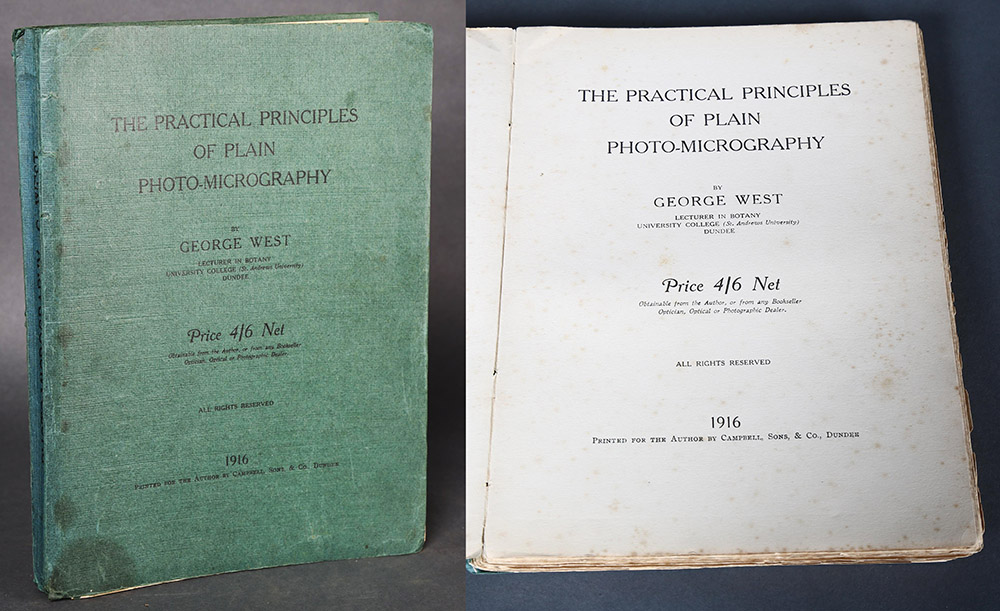
Figure 5.
Cover and title page of George T. West’s 1916 book, “The Practical Principles of Plain Photomicrography”. Adapted for nonprofit, educational purposes from an internet auction site.
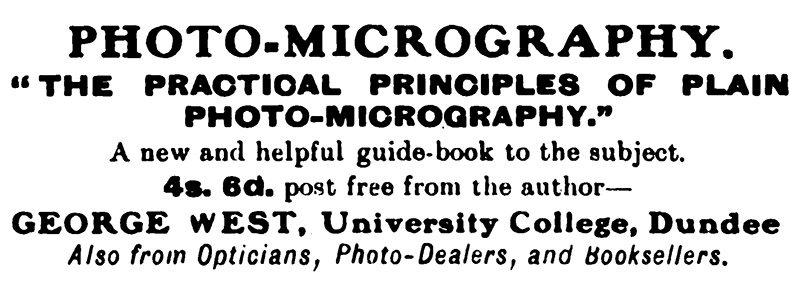
Figure 6.
1916 advertisement for “The Practical Principles of Plain Photomicrography”. From “Nature”.

Figure 7. .
Diagram of George West’s setup for taking photographs through a microscope, from “The Practical Principles of Plain Photomicrography”.
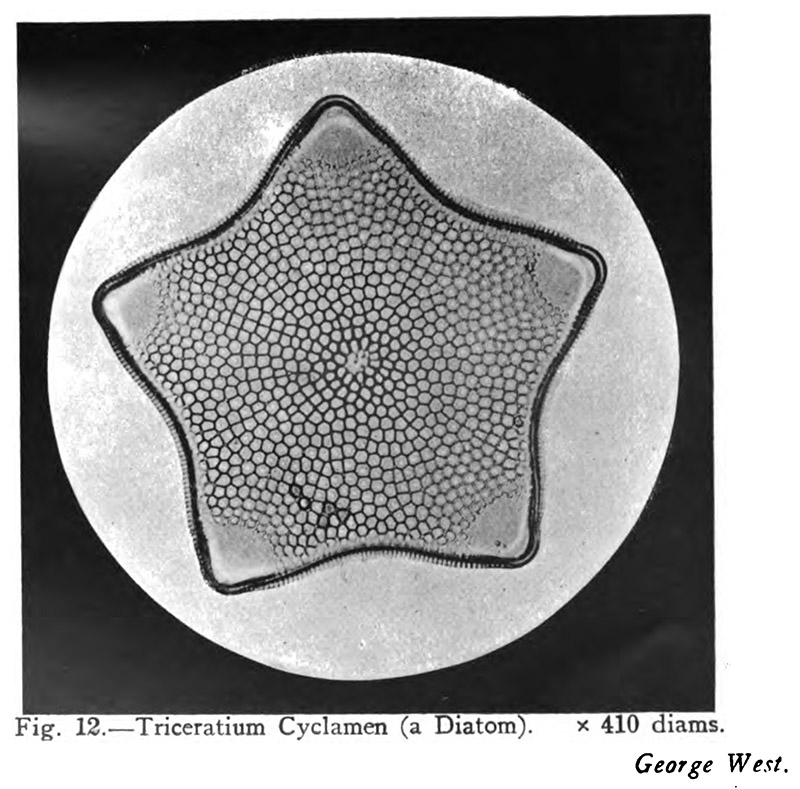
Figure 8.
Photomicrograph of a diatom, taken by George T. West. From “The Practical Principles of Plain Photomicrography”.

Figure 9.
West included “An open letter to diatomists” in his “The Practical Principles of Plain Photomicrography”, with plans to issue a series of microscope slides on “Diatomaceae of Scotland”. This plan appears not to have come to fruition.
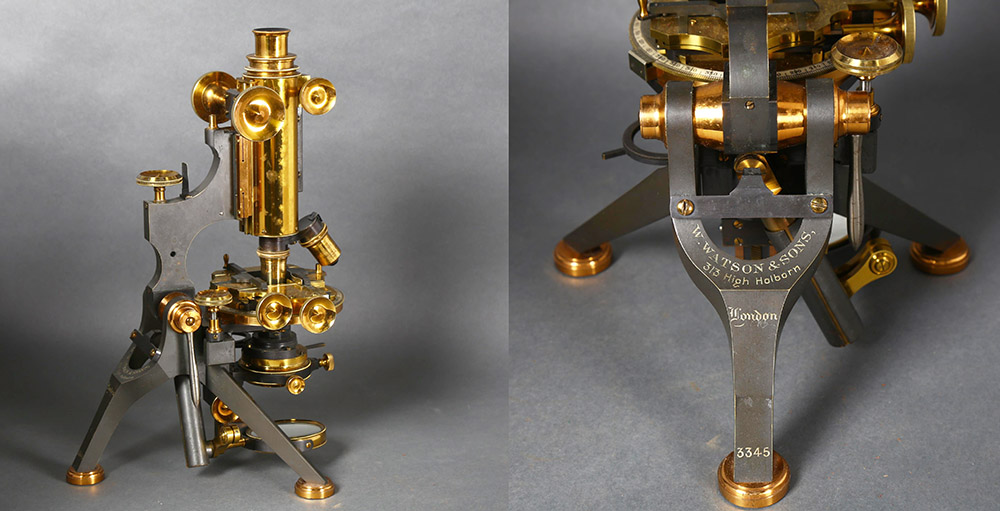
Figure 10.
One of George T. West’s microscopes, a Watson & Sons “Van Heurck” model, serial number 3345. It was among his possessions that were auctioned in March, 2024. Adapted for nonprofit, educational purposes from https://auctions.burstowandhewett.co.uk/catalogue/174EE54E5F76C913508459C8B49CC757/C87E406E317D82BB64ED7E2EBC5BB166/science-natural-history-and-curiosities/

Figure 3.
Another of George T. West’s microscopes, Watson & Sons serial number 3365. Adapted for nonprofit, educational purposes from https://auctions.burstowandhewett.co.uk/catalogue/174EE54E5F76C913508459C8B49CC757/C87E406E317D82BB64ED7E2EBC5BB166/science-natural-history-and-curiosities/
Resources
Antiques Trade Gazette (2024) Botanical Battle auction action, April 20 issue, page 15
Carnegie Trust for the Universities of Scotland, Annual Report (1913) “George West, Lecturer in Botany, University College, Dundee – the diatom flora of Scotland”, page 37
England census and other records, accessed through ancestry.com
Gill, Steve (2014) The Bernard Hartley sample and strewn slide collection index, pages 42-45, accessed through microscopy-uk.org.uk/diatomist/BHindex.pdf
Henderson, Ellen B. (1924) Notes on a diatomaceous deposit at Dalmahoy, Edinburgh, Transactions of the Botanical Society of Edinburgh, page 135-144
Hereford Times (2004) Sweeping away the dusty image, February 19 issue, accessed through herefordtimes.com/news/5666564.sweeping-away-the-dusty-image
Journal of the Linnaean Society, Botany (1935) Vol. 49, page 261
Journal of the Quekett Microscopical Club (1899) Description of G.T. West’s table stage, page 239
Journal of the Quekett Microscopical Club (1899) Minutes of the May 19, 1899 Ordinary Meeting, page 244
Journal of the Quekett Microscopical Club (1903) Members: “May 19, 1899. West, George T., 128, Kentish Town Road, N.W.”
Journal of the Quekett Microscopical Club (1904) George T. West not listed as being a member
Journal of the Royal Microscopical Society (1919) Amphora inflexa, a Rare British Diatom - G. West, page 81
Knowledge (1916) Review of The Practical Principles of Plain Photomicrography, page 132
Nature (1899) Report on the May 17 meeting of the Royal Microscopical Society, page 167
Nature (1916) Review of The Practical Principles of Plain Photomicrography, pages 47-48
Nature (1916) Advertisement for The Practical Principles of Plain Photomicrography, September 16 advertising section, page ii
Nelson, E.M. (1900) President’s Address (included, “Messrs. Watson and Son exhibited a very simple and ingenious hot stage and stage preserver, designed by Mr. G.T. West”, pages 153-159
The Newport, Wormit & Forgan Archive (accessed February, 2025) 24 St. Ford Road, newportarchive.co.uk/property.php?ID=104100
Ogilvie, H.S. (1908) The microscope and nature, English Mechanic and World of Science and Art, page 143
Probate of the will of George T. West (1947) “West George Thomas otherwise George of 19 Chevening-road Willesden London NW6 died 14 August 1946 at Central Middlesex County Hospital Willesden Probate London 22 March to Emma Charlotte West widow. Effects £1708 19s 2d”, accessed through ancestry.com
Scotland census and other records, accessed through scotlandspeople.gov.uk
Southgate, Donald (1982) University Education in Dundee, A Centenary History, University of Dundee, page 157
West, George (1899) New stage table, Hardwicke’s Science-Gossip, page 30
West, George (1910) An epitome of a comparative study of the dominant phanerogamic and higher cryptogamic flora of aquatic habit, in seven lake areas in Scotland, in Bathymetric Survey of the Fresh Water Lochs of Scotland, Vol. 1, edited by John Murray and Laurence Pullar, Challenger Office, Edinburgh, pages 156-260
West, George (1916) The Practical Principles of Plain Photomicrography, G. West, Dundee
West, George (1916) Remarks on Amphipleura, English Mechanic and World of Science, pages 293-294
West, George (1916) Amphora inflexa, a rare British diatom, Journal of the Quekett Microscopical Club, pages 35-40










